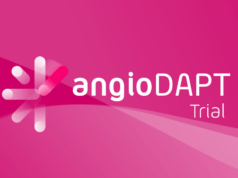A study published, as a research letter, in the Journal of the American College of Cardiology indicates that smartphone communication among medical teams at different hospitals can significantly reduce the time it takes for myocardial infarction patients to get lifesaving treatment after a hospital transfer. It showed that patients with ST-segment elevated myocardial infarction (STEMI) needing a hospital transfer underwent percutaneous coronary intervention (PCI)—on average—27 minutes faster when their medical teams used a smartphone app-based social network system (SNS) to coordinate the hospital transfer than patients whose medical teams communicated with a non-smartphone based STEMI hotline.
Researchers Jin Joo Park (Seoul National University Bundang Hospital, Seoul, South Korea) sought to reduce the door-to-needle time of STEMI patients who have to be transferred from the admitting hospital to a PCI-equipped hospital to receive the procedure. Therefore, they evaluated the use of the smartphone app “BAND”—is a popular social networking app in South Korea that facilitates communication among groups
When transferring a STEMI patient to a PCI-equipped hospital, physicians used the app to send the interventional cardiologist basic patient information along with a picture of the patient’s electrocardiogram taken with a smartphone camera. The interventional cardiologist used this information to rapidly gather a team to perform PCI, paging on-call personnel when needed, so that in most cases the responding team assembled at the hospital before the
Of 114 patients enrolled in the study, 50 were transferred to using the app and the rest were transferred using a non-smartphone based STEMI hotline. Park et al found that use of the BAND app a 27-minute reduction, on average, in the length of time from first medical contact to receiving PCI. One key factor that likely contributed to this reduction was the time spent waiting to undergo PCI after arriving at the second hospital, which was more than 15 minutes shorter when the app was used to facilitate a transfer for patients presenting during off-hours. The use of the app in these cases reduced the wait time at the second hospital to that experienced by patients arriving during weekdays. The time spent in transit between the two hospitals was similar in both groups. The time spent at the first hospital before being transferred was numerically shorter in the app-activated group, but this difference was not statistically significant. According to an AHA press release, the benefit of the app was especially pronounced during nights and weekends, when on-call medical teams may be off site and have to travel to the hospital to perform the procedure.
“Social network system (SNS) [with the app] activation is a simple and cost-effective method suitable for broad use and implementation among health care providers to reduce the total ischemic time for transferred STEMI patients. In my opinion, SNS activation can potentially save lives without using new resources in the health care system,” Park says.
The study is limited in that it is not a randomised controlled trial and does not assess whether the use of SNS to streamline the transfer process actually saves patients’ lives or improves their quality of life. Park and his team are currently planning a randomised clinical trial to provide a more rigorous evaluation of the potential impact of SNS use on these outcomes.












